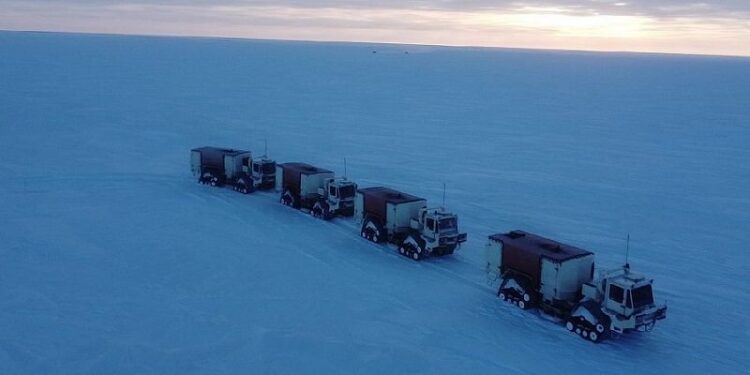TNG-Group Carried out Seismic Exploration in Difficult Conditions of Yamal
The company’s work was hampered by patchy ice, impassable bushes, and reindeer movements.
Seismic crew No. 20 of TNG-Yugraservis conducted research in the Yamalo-Nenets Autonomous Okrug in the past winter field season. The project was completed ahead of schedule, despite the difficult working conditions. The Devon News Agency learned about this from the press service of the oil service company TNG-Group.
The studies were carried out in difficult orohydrographic conditions on land and in water areas. More than 70% of the total area there is covered with water.
“Carrying out research in the water area is quite dangerous in itself,” says the chief engineer of the seismic crew, Ruslan Sadykov. “To reduce risks and prevent accidents, the party team spent a lot of effort and resources on a detailed study of the entire ice surface.”
At each seismic wave generation point, the thickness of the ice and the depth of the sub-ice water were measured. Maps were drawn up with these measurements. In addition, seismic surveyors monitored the ice condition daily. Topographers under the leadership of Oleg Talabaev carried out reconnaissance of the area and located the initiation points.
The matter was complicated by the fact that the ice was heterogeneous, in places loose and saturated with water. There were areas with cracks and ice hummocks formed during periods of high and low tides. In just one season, more than three and a half thousand holes were drilled in two areas to study the thickness of the ice and the depth of sub-ice water. More than 20 km of crossings were frozen and more than 50 dams were made.
Despite the additional work, TNG-Group managed to cope with the task. During work in a huge water area – about 140 sq. km – there was not a single flooding of seismic signal excitation installations (SVSS) and light tracked vehicles.
On land, due to dense vegetation in the floodplain area of the Shuga River, it was necessary to clear the area. However, deforestation had to be postponed. In addition, it was necessary to conduct geophysical observation on the ground, taking into account measurements of ice thickness and water depth.
Geophysicists organized warm-up exercises in the water area. They froze and built dams in areas where the ice thickness was not sufficient for the operation of vibration sources. Taking into account the fact that the weight of the vibration installation is 42 tons, the thickness of the ice must be at least one meter.
“At the end of March, a large translocation of deer was planned, about 500 thousand heads,” Sadykov explained. – The transfer route passed through our square. Taking into account these two factors, the management decided to set up geophysical observation points and lay seismic equipment without cutting in the river floodplain.”
“The topographic team and the seismic team had to overcome snowdrifts and tall, almost impassable bushes. – added the chief engineer. – And the party workers coped with this task successfully. They managed not only to lay out the seismic equipment and work on the site, but even after completing the work, assemble the equipment before the arrival of the deer and the onset of the spring thaw.”
Recently, the Devon news agency wrote about how divisions of TNG-Group (part of TagraS-Holding) carried out seismic exploration in the Nenets Autonomous Okrug and the Krasnoyarsk Territory in the most difficult conditions. They explored the coast of the Barents Sea. At the same time, workers faced abnormal flooding and a powerful tide. Because of this, geophysicists found themselves cut off from the mainland for three weeks. Some of the equipment was carried away on ice floes. Despite this, the work was completed efficiently and on time.











